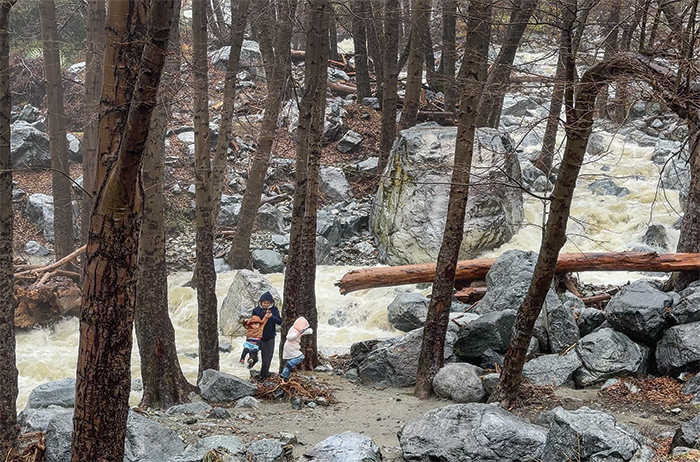RSABG explores deep roots of native plants in movie industry
Rancho Santa Ana Botanic Garden is the site of a creative new exhibit exploring the intersection of botany and cinema. “On Location: California Native Plants in the Movies” is on view through October 23.
The first component of the show is an exhibit housed in the RSABG gallery, which includes a timeline, denoted by tree rings, of the history of the use of California’s indigenous fauna in movies.
For instance, in Alfred Hitchcock’s 1958 psychological thriller Vertigo made use of a redwood forest. Moving forward to 1974, Blazing Saddles—a comic send-up of Westerns and racial stereotypes in film—takes viewers into the dry as dust frontier town of Rock Ridge, thanks to the presence of California natives like chaparral yucca.
And in Steven Spielberg’s 1982 blockbuster ET: The Extra Terrestrial, not only are there visual references to botany in the film’s usage of the forests of the Golden State, the title alien is himself an otherworldly botanist.
Along with movie stills, the gallery and info-graphics on topics like the use of certain plant-related tropes in films. These include killer plants (who can forget Little Shop of Horrors?) and poison berries, which figure prominently in the Hunger Games, among other films. Another engaging feature is one-page excerpts of scripts of movies like Sideways, Into the Wild, Wild and Avatar, where plants take center stage.
The second part of the exhibit is 14 movie stills, from films ranging from Cars to Jurassic Park, placed throughout the Garden and juxtaposed against the native plants. You can follow a map available in the gallery for a self-guided tour or discover the stills like hidden treasure as you stroll the grounds.
One of the films highlighted is Return of the Jedi, whose scenes on the Forest Moon of Endor—home to Ewoks and to a mad chase through the trees on speeder bikes—feature California redwoods. Stills from the movie can be seen in the gallery and in the forefront of a stand of redwoods growing in the Garden.
Another sci-fi hit, the original 1968 version of Planet of the Apes, is also referenced. A still of the dystopian film, much of which was filmed in the Santa Monica Mountains, shows the apes’ village set against a hill covered with coastal sage scrub. Native sage flourishes behind the still.
Westerns, which were particularly popular in the ‘50s and ‘60s, utilized California native plants and landscapes more than any other genre. One of the Westerns highlighted in “On Location” is Tell Them Willie Boy is Here, a film that, like the RSABG, is marked by the presence of Joshua trees.
Then there’s the heartbreaking and heartwarming Old Yeller (1957). The movie was supposed to be set in Texas but was filmed instead at Walt Disney’s Golden Oak Ranch in Newhall and in sites in Santa Clarita. Coast live oaks and Valley oaks, both of which grow at RSAB, stand in for the Texas live oaks in the story.
“On Location” was curated by RSABG’s new communications and graphic specialist David Bryant, who has been at the Garden since April. A graduate of the Rhode Island School of Design, he has always been fascinated by both art and nature.
“I grew up on a pecan orchard in Texas, so I have a familiarity and sensitivity to native plants,” he said. “When I went to art school, I was constantly looking at the landscape and the wild. It’s kind of been my pursuit to really marry my passion for the environment with my art practice.”
He explained his process in coming up with the idea for the exhibit.
“I’ve always been botanizing movies, since who knows when,” Mr. Bryant said. “I felt like it was a ripe place to explore that further.”
On Location took quite a bit of work to put together. He said people who are into plants have a tendency to “nerd out” with movies, trying to identify the plant species in movies. Thus, he started by canvassing employees and volunteers at the Garden, looking for their suggestions of movies on which to focus.
Then, he headed for the Academy of Motion Picture Arts and Sciences’ Margaret Herrick Library in Beverly Hills, accompanied by Hannah Stewart, an intern from the Getty Foundation.
“It’s such an amazing resource. It was a fun process,” Mr. Bryant said of the days they spent poring through the archives. “You’d ask for a title, say Star Wars Episode VI. And you’d get boxes of files back that had tons of imagery and film stills and memorabilia and rifle through those, looking for those that contained plants.”
Mr. Bryant said it is truly a rich subject to explore, he said, pointing as an example to the primacy of plants in Return of the Jedi.
“It’s filmed in the redwoods, up in northern California,” Mr. Bryant said. “Being in the forest, with these huge living organisms, it was the perfect metaphor for Luke Skywalker’s maturity. You feel so dwarfed by these trees in terms of time and scale, and there’s something magical about that. It’s the perfect sanctuary and the perfect spot for a reawakening.”
RSABG is located at 1500 N. College Ave. in Claremont. Admission is $8, $6 for students and seniors and $4 for kids ages 3-12. For information, visit rsabg.org or call (909) 625-8767.
—Sarah Torribio
storribio@claremont-courier.com









0 Comments